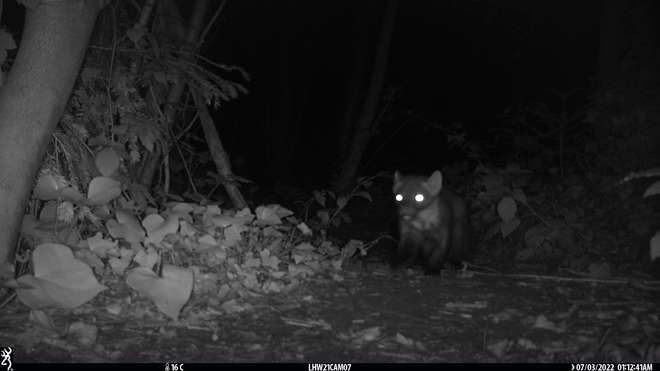Pine martens are an arboreal hunter. It is native to Europe, stretching into Asia in areas such as Iran and Syria. It is also a native part of the UK ecosystem. Unfortunately, as an arboreal predator the pine marten was horrifically reduced in the UK by the destruction of our rainforests. What few animals continued to survive in fragments of forest left behind, have been persecuted by farmers for their habits of taking chickens and similar animals.
This is why this sighting of a pine marten on the edge of London is so exciting.

After much of the forest of the UK was lost, a wealthy landowner introduced an exotic species to their land. This is not uncommon. A variety of exotic species have been introduced – this was largely done before it was realized how much of a problem it could be.
The grey squirrel did very well, and quickly spread beyond this estate. As a carrier of an illness call squirrel pox, what usually happens is that when a grey squirrel moves into a habitat the reds disappear.
Should we just allow the red squirrel to disappear? Well, there is a problem with that.
There is a reason that red squirrels are smaller and more agile than grey squirrels. The red squirrel evolved alongside the pine marten. Requiring the need to escape to the smallest branches at the top of the tree (where the heavier pine marten cannot follow) the red squirrel got far smaller than its grey counterpart. However, if the pine marten was to recover the grey squirrel would likely be lost.
This is why this pine marten sighting on the edge of London is so exciting. Currently, grey squirrel populations throughout England are regularly boosted by city greys migrating out of the city. As pine martens are shy, they are unlikely to ever move into cities in a big way.
However, with the recovery of the Pine marten, all areas of suitable habitat in the UK could become grey squirrel no go areas. This could greatly reduce the numbers of grey squirrels, and reduce their ability to move around the country, leading to a hopeful decline and eradication in the UK. This process has occurred in Ireland.
Now, currently the pine marten is naturally moving into northern England, in areas such as the North yorkshire mores, and the Kielder forest of Northumberland have both had sightings in recent years. There is now a population of about 50 in central wales – there were some sightings of Pine martens, and while little was known about the initial population, it has been boosted by translocations from Scotland, and there is now thought to be about 50. With no persecution, this population is likely to grow at a healthy rate.
Oddly, there has also been repeated sightings of Pine martens in the new forest at the bottom of the UK. It is thought that this population may be the result of illegal translocations, though this work should clearly have been done by the government.
This is a video of various pine marten sightings in the new forest, alongside sightings of various other wild species.
Clearly the pine marten has a great deal of recovering to do, but my hope is that, like in Ireland, as the pine marten recovers the grey squirrel declines and allows the red squirrel to return. There is more conversation about reintroducing them to places such as Kent.











